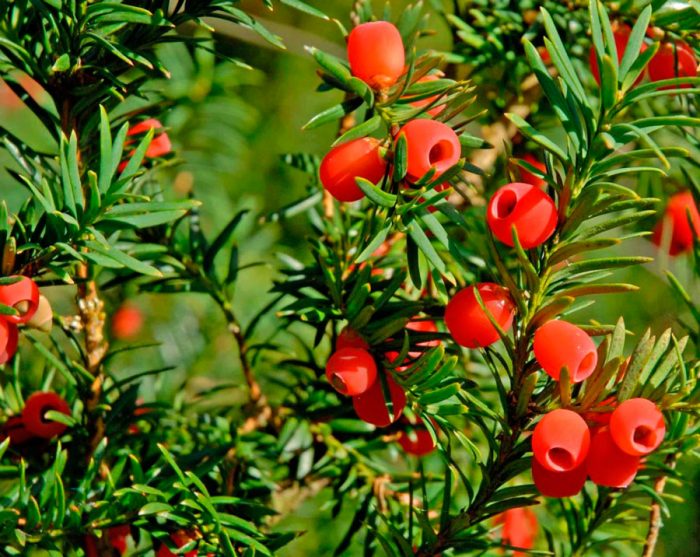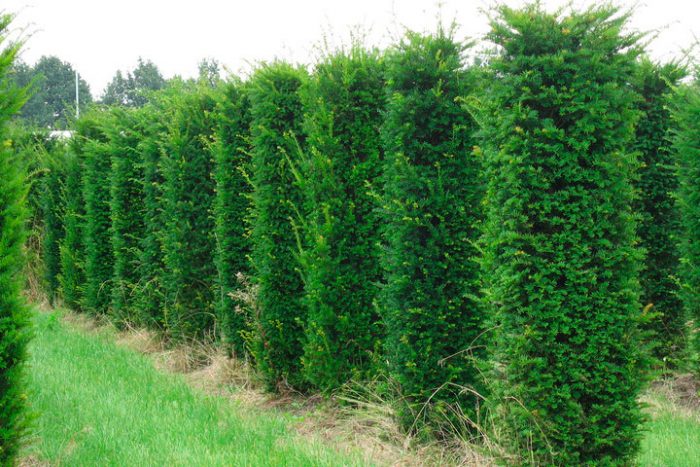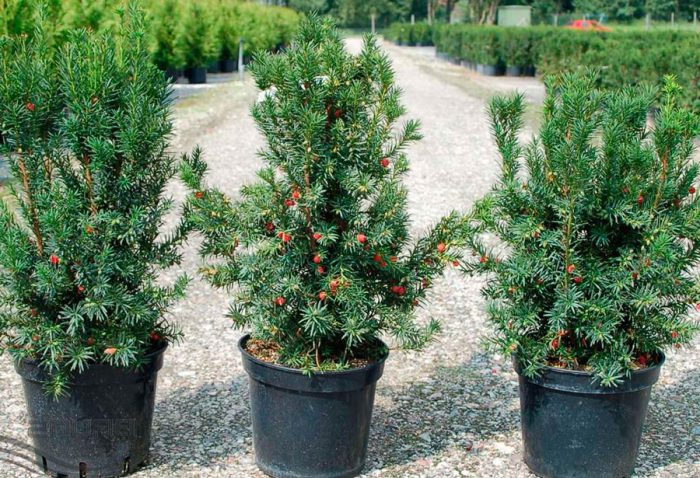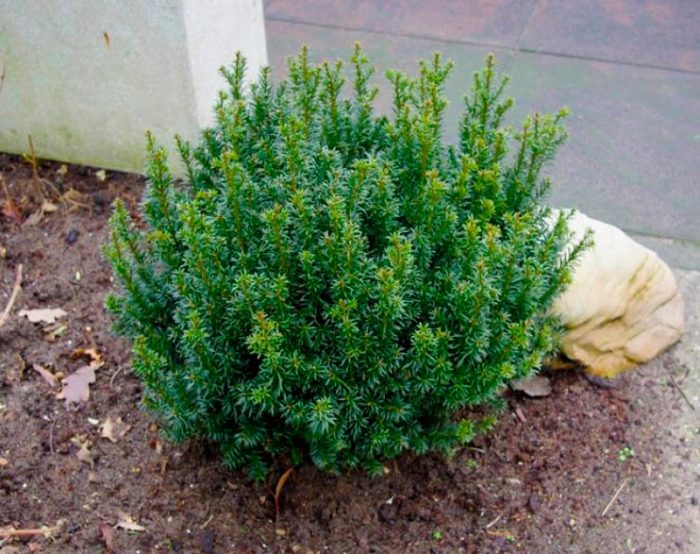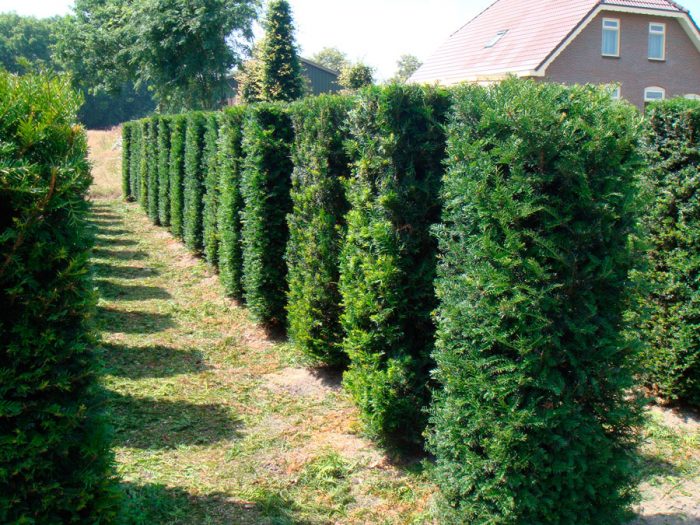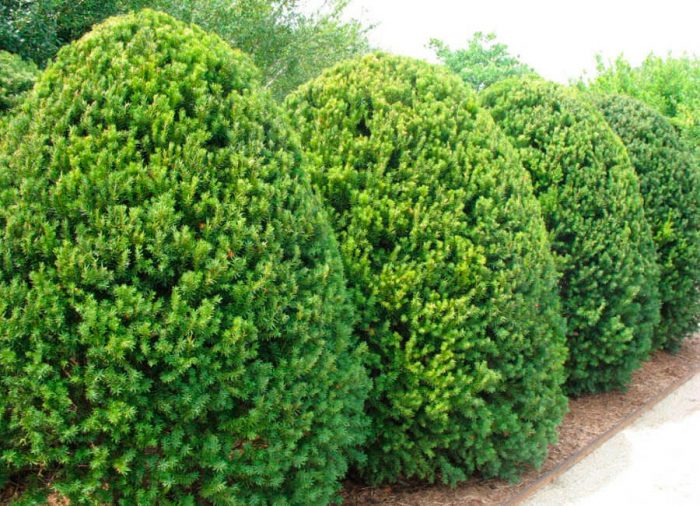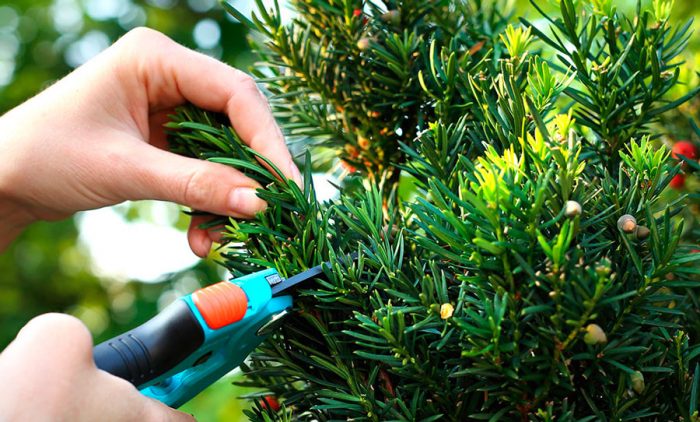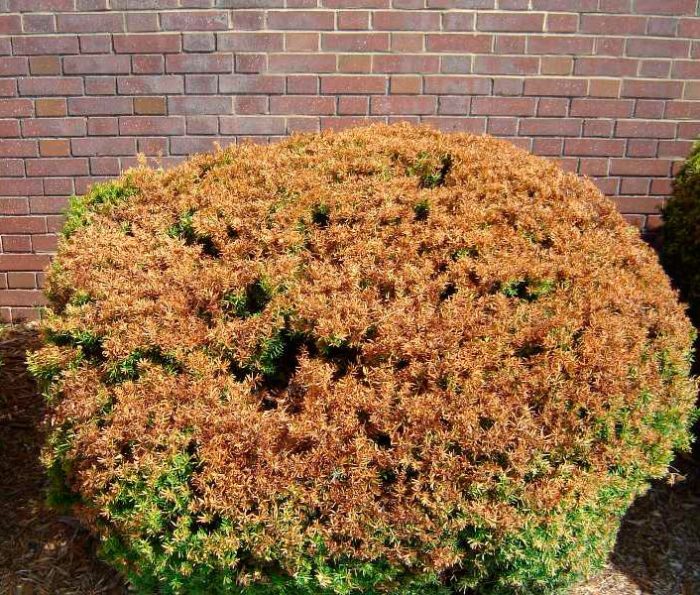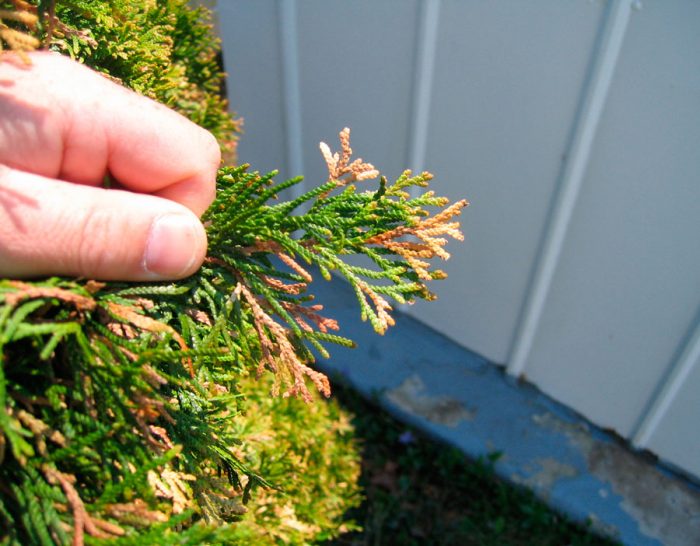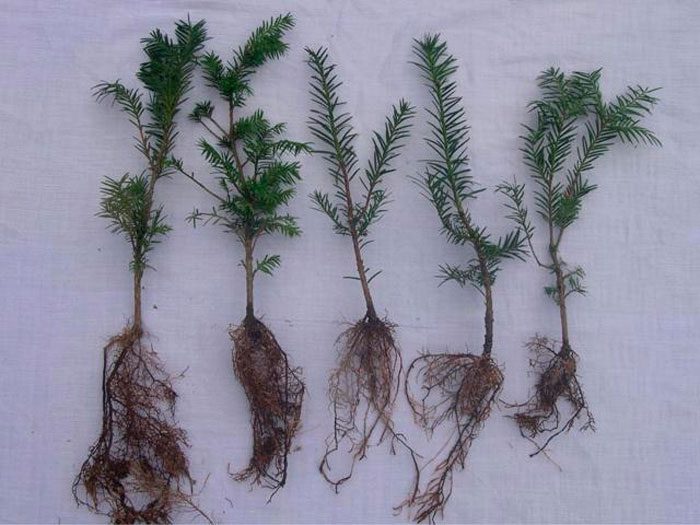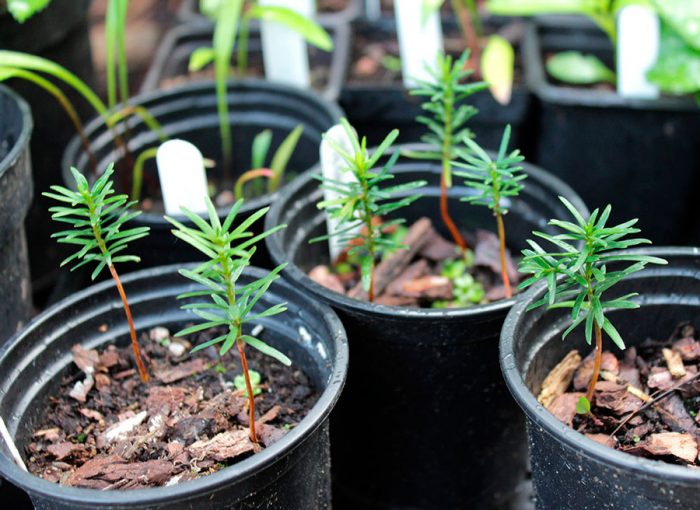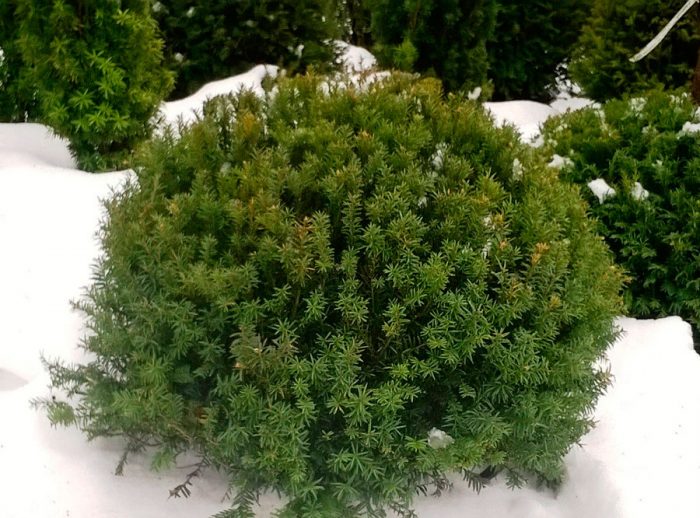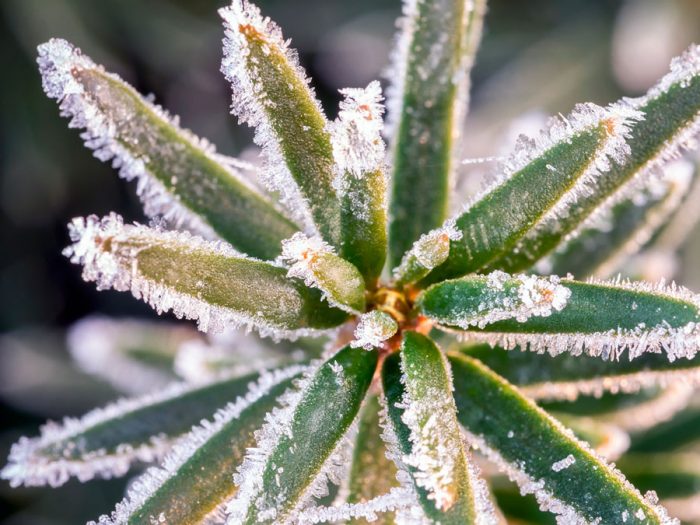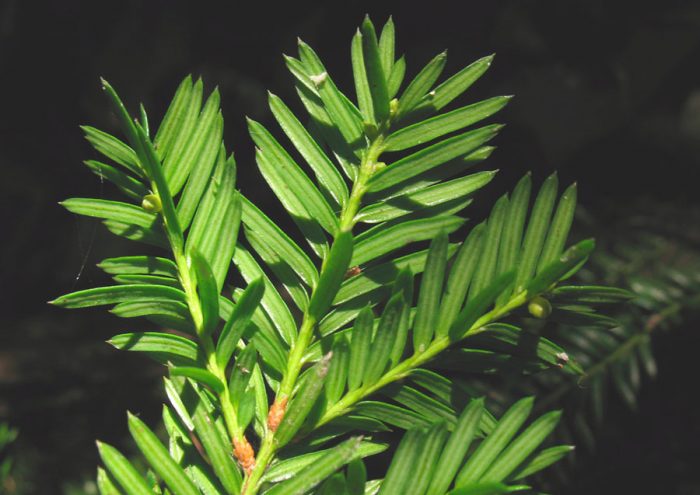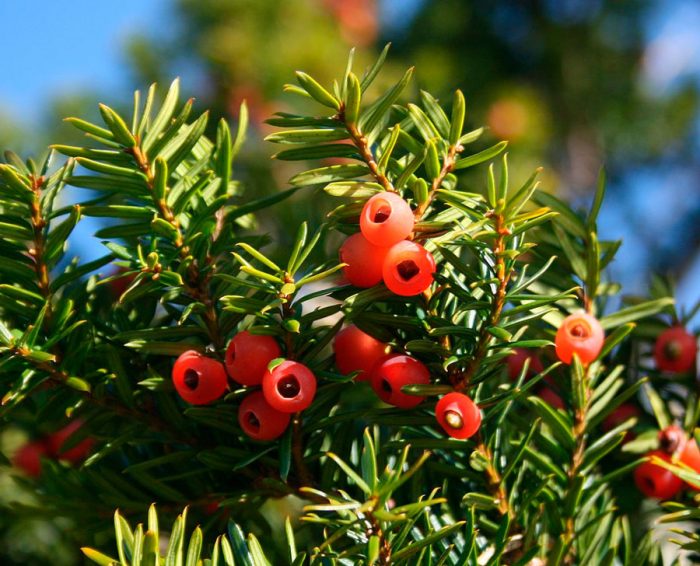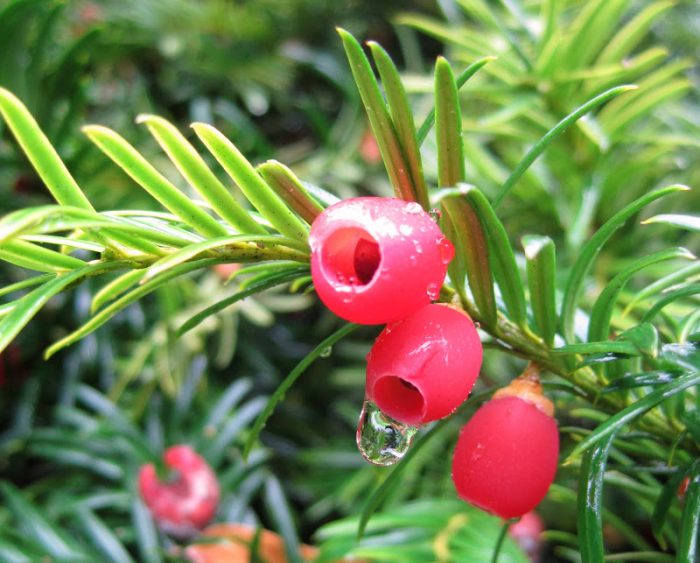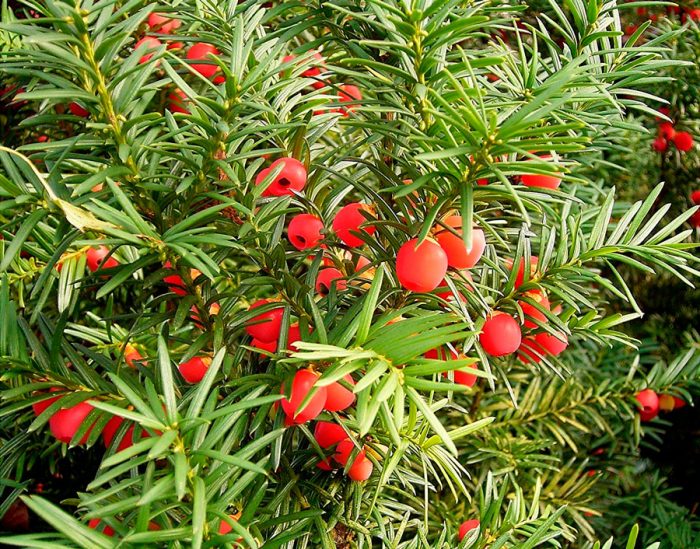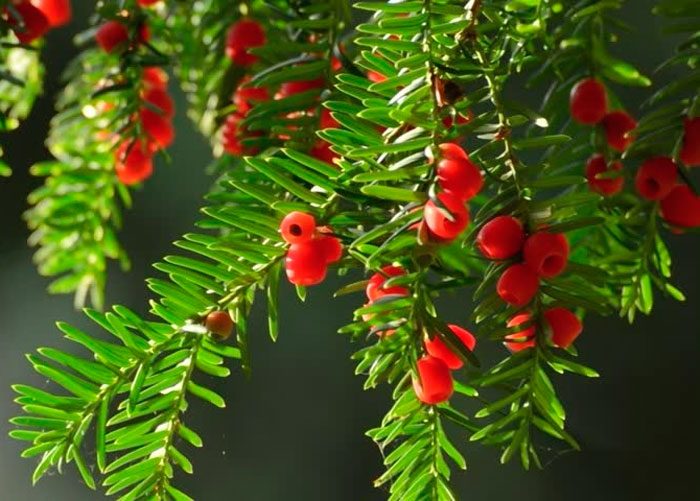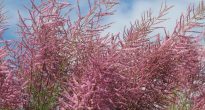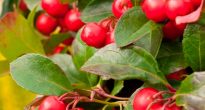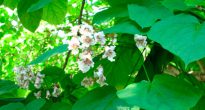The yew plant (Taxus), also called yew, is a member of the Yew family. This genus unites about 8 species of coniferous trees and shrubs, which are characterized by slow growth. 3 species are found in Asia, including the Far East, 1 species in northern Africa and Europe, and 4 species in North America. This culture is very popular among gardeners, it is used in landscape design, since yew is unpretentious and highly decorative, but in natural conditions this plant is less and less common every year.
Content
Features of yew
Representatives of the Yew genus are dioecious plants. The brown-red bark of such a plant is scaly. Crohn has an ovoid-cylindrical shape, often it is multi-vertex. The branches are whorled on the trunk. The flat and soft needles are colored dark green, they are placed on the lateral branches in two rows, and on the stems - in a spiral. Needles in length can reach 20–35 mm. The formation of red fruits is observed on female trees; such berries remain on the branches until the onset of winter. The height of the shrub yew almost never exceeds 10 m, while the tree-like species can be higher than 20-30 m, and its trunk reaches 4 meters in diameter. In such a plant, wood has antibacterial properties, since it contains many phytoncides. Furniture or floors in the house are made from it, thanks to which it is possible to protect the home from infections. Due to the fact that this plant possesses such a valuable wood, popularly referred to as "non-gnaw-tree", it fell into the Red Book.
Yew can live for about three thousand years, and it also differs in that it is capable of rapidly recovering after pruning, due to which the gardener can create various forms from its crown. Such a culture also differs in that it is the most shade-loving, but it also grows very well in sunny areas. If you decide to grow yew, then remember that all its parts contain poison.
Planting yew in open ground
What time to plant
Yew is planted in open ground from the last days of August to October. In areas with a mild climate, such a plant is planted in October, in the area that, according to the gardener, is most suitable for this. If in the region where the yew will be grown, the summer period is relatively short, then it is recommended to plant it in the last summer or first autumn weeks, and for this you should definitely choose well-lit areas. If the seedling has a closed root system, then it can be planted throughout the entire growing season, but this procedure must be completed by October in areas with mild winters, and no later than the first half of September - in regions with colder climates and short summers.
We must try to protect such a plant from drafts at least for the first few years after planting the seedling in open soil. It is recommended to grow yew in well-drained, light and fertile soil, its composition may be approximately as follows: sand, peat and leafy or soddy soil (2: 2: 3). But it should be borne in mind that it grows quite well on poor soil. Overly moist or too acidic soil is completely unsuitable for this culture.
Landing rules
To plant a seedling, it is necessary to prepare a hole, the depth of which should be at least 0.7 m, while its width should be 0.2 m greater than the volume of the root system of the seedling taken with a lump of earth. To create a hedge, it is recommended to plant seedlings in a trench, the depth of which should be about 0.5–0.7 m. A distance of 150–200 cm should be kept between the bushes, while when planting a hedge, it should be less - about 50 cm. When the pit is ready, it is necessary to make a good drainage layer at its bottom, the thickness of which should be about 0.2 m. Broken brick, crushed stone, river sand or pebbles can act as a drainage material.
The seedling in the container must be watered very well, after which it is carefully pulled out of the container and placed in the planting pit. The free space in the pit must be filled with a pre-prepared soil mixture (see composition above), to which complex mineral fertilizer must be added. For example, you can use Nitroammofosku (for 1 liter of soil 1 gram), Kemiru-universal (for 1 m2 soil mixture 100 grams) or copper sulfate (15 grams per 1 liter of earth). After planting is completed, the root collar of the plant should be flush with the surface of the site. When the yew is planted, the soil around the bush must be well tamped. Water it well, and after the liquid is completely absorbed into the soil, the surface of the trunk circle must be covered with a layer of mulch (peat or compost).
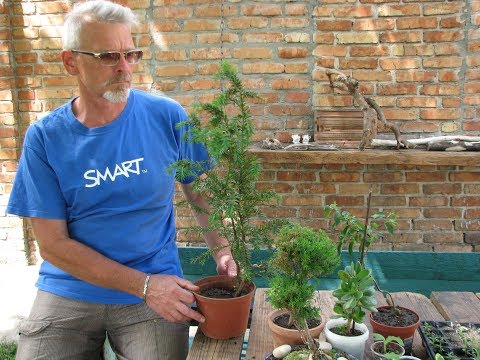

Watch this video on YouTube
Yew Garden Care
It is relatively easy to grow a yew tree in your garden. This plant needs systematic watering and loosening of the soil surface, while its near-stem circle should always be clean. Young bushes must be covered for the winter, and in spring they need to be protected from sunburn. It is also recommended to systematically carry out preventive treatments that will help protect the bushes from diseases and pests. As the plant grows, it may need regular pruning.
Watering and loosening
Yews that are less than 3 years old need to be watered systematically. This should be done 1 time in 4 weeks, while 10 to 15 liters of water should be consumed per 1 bush for 1 watering. Adult plants rarely need watering, as a rule, they have enough rainwater. In addition, such plants are able, if necessary, to extract liquid from deep layers of the soil, a powerful root system helps them in this. However, during a prolonged drought, the plant must be provided with systematic watering, as well as sprinkling of the crown.The moistened soil in the near-stem circle must be loosened to a depth of 10 to 15 centimeters, especially during the first 3 years after planting the yew in open soil. If this is not done, then a crust will appear on the ground, which will block the access of oxygen to the root system. At the same time, with loosening, it is necessary to pull out all the weeds, since pests often settle on them. If there is a desire to reduce the number of weeding, loosening and watering, then the surface of the trunk circle should be covered with a layer of mulch (needles, peat or sawdust), the thickness of which should be from 8 to 10 centimeters.
Top dressing
If during the planting of the bush all the necessary fertilizers were introduced into the soil, then they will be enough for the whole year. Then top dressing will need to be applied to the soil every year. To do this, you can use the Kemiru station wagon (1 m2 100 grams) or Nitroammofosk (for 1 m2 from 50 to 70 grams).
Pruning
Such a plant is characterized by very slow growth; therefore, it does not need to be cut off in the first years. Mature shrubs and trees lend themselves well to crown formation. Even excessively strong pruning cannot harm them. The stems should be shortened by no more than 1/3 of the length. It is imperative to cut out all dried, as well as branches affected by frost or disease. It is recommended to prune the plant in the first days of April before the buds swell.


Watch this video on YouTube
Transfer
It is recommended to transplant such a culture in the spring, while the soil should be well warmed up. First, you should select a site and make a landing pit of the required size (see above for more details). Remove the bush and place it in a new pit, while the root collar, upon completion of planting, should be flush with the surface of the site. At the end of the transplant, the plant is watered abundantly, and the surface is covered with a layer of mulch (organic material).
Diseases and pests
Pests
Yew can be harmed by such pests as gall midges and false shields, which are sucking insects, and spruce needle-eaters and pine scoops - these are needle-gnawing pests, can also harm it. On the bush on which harmful insects have settled, yellowing, drying and dying of branches, as well as needles, is observed. Experts advise annually in spring to spray the bushes and the surface of the trunk circle with a solution of Nitrafen or Karbofos. If harmful insects are found on the plant during the growing season, then the bush and the surface of the trunk circle must be sprayed 2-3 times with Rogor or another means of similar action. As a rule, 1 treatment is not enough for the complete destruction of pests, therefore, after 10-12 days, treat the plant once more with the same preparation.
Diseases
For such a culture, the following diseases are dangerous: brown shute, phomosis, necrosis and fusarium. The symptoms of such diseases are different, however, the change in the appearance of the needles should cause anxiety. Most often, the development of diseases is facilitated by mechanical injury to the bark, because of this, various fungal infections enter the plant. Also, specimens very often get sick, for the cultivation of which a lowland with a clayey heavy soil has been chosen. To improve drainage and remove excess water from the soil, it is necessary to drive several pieces of plastic pipe into the soil around the perimeter of the near-stem, the length of which should be about 0.3 m, while the diseased bush itself must be sprayed with biofungicide. For preventive purposes in spring and autumn, the yew must be treated with a fungicide containing copper.
Reproduction of yew
Yew can be propagated by cuttings and seeds. Generative propagation is relatively laborious, and seedlings grown from seeds, in most cases, do not retain the varietal characteristics of the parent plant.In this regard, this method of reproduction is used only during the cultivation of the species yew or when breeding new varieties of such a crop. It is much easier and faster to propagate this plant by cuttings, plus young plants always inherit the parental varietal traits.
Such a plant can still be propagated by grafting in stock. However, this breeding method is only suitable for specialists.
Propagation of yew by cuttings
Cuttings are harvested from three to five-year-old stems, while the length of the segments should be from 15 to 20 centimeters. They are harvested in September and October or in April and May. In cuttings, the lower part must be freed from the bark, while the cut points must be treated with a growth stimulating agent. Then the prepared cuttings are planted in tubs, which must be filled with a soil mixture consisting of peat and sand (2: 1). If cuttings are made in the autumn, then the cuttings must be kept in a sufficiently warm place throughout the winter, and with the onset of spring it is necessary to plant them in open ground. If this procedure is carried out in spring, then for a start, it is recommended to plant the cuttings under a film in a greenhouse. And after they take root, they are transplanted to the garden plot. Duration of rooting of cuttings is about 3-4 months, while during this time the soil around them should be moist. It is necessary to remove the shelter from the cuttings only in the last summer weeks, in this case the plants will have time to adapt to the cold. During the first 3 years, young plants must be covered for the winter, which will help protect the root system from frost.
Growing yew from seeds
If stored correctly, the seeds will remain viable for about 4 years. Experts advise sowing freshly harvested seeds in autumn. If the sowing of seeds is postponed until spring, then they will need cold stratification, for this they are kept in a refrigerator for at least 6 months at a temperature of 3 to 5 degrees. Thanks to this, seed germination will increase significantly. Seeds are sown in March; for this, containers are filled with a previously disinfected soil mixture. They are deepened by half a centimeter, the container must be covered with a film on top, then it is removed to a warm place. The first seedlings should appear in about 8 weeks, when sowing seeds that have not been stratified, they may appear only after 1-3 years. A couple of years after the germination of the seeds, the grown plants must be laid out on the garden bed in the greenhouse, after another 2 years the yew is planted in the school. The plant will grow there for 3 or 4 years, after which the seedlings can be transplanted to a permanent place.
Yew in winter
Autumn care
When leaf fall ends, the plant will need to be sprayed in order to prevent pests and diseases, for this you need to use a solution of a fungicidal preparation. Young trees, which are less than 3 years old, need to be covered for the winter; for this, the trunk circle is covered with a layer of dried foliage of decorative rocks or peat, the thickness of which should be from 50 to 70 mm. Young trees have very fragile branches and they can be easily injured under the weight of snow; they must be carefully pulled to the trunk and pulled into a bunch.
Wintering
If a winter with little snow is expected, then the yew can be severely damaged from a severe frost. To prevent this, the bush should be wrapped with lutrasil or spunbond, but first you need to install the frame, because it is necessary that there must be free space between the tree and the covering material. It is not recommended to cover the yew with sackcloth, since during the thaw it becomes wet and then becomes covered with ice. Also for this purpose it is better not to use roofing material and polyethylene, since this material does not allow air to penetrate to the branches. It is necessary to remove the shelter in the spring after the soil warms up well.But at this time it is imperative to protect the yew from direct sunlight before the formation of young growths, since in the spring the sun is most active, and because of this it can be severely damaged. In spring, in windy and cloudless weather, the root system that has not fully recovered is not able to absorb water normally, at the same time there is active evaporation of moisture by the needles, which is why yews are easily injured. It is because of this that the plant needs shading from the sun's rays at this time of the year.
Types and varieties of yew with photos and names
Below will be described those types and varieties of yew, which are most popular.
Canadian Yew (Taxus canadensis)
The height of such a bushy recumbent tree does not exceed 200 cm; its homeland is the forests of eastern North America. The stems are short and covered with a large number of needles, the branches are ascending. The needles have a sickle-curved shape, they are sharply pointed. The upper side of the needles is greenish-yellow in color, and the lower side is pale green with lighter stripes. The species has a high frost resistance. Such a yew tree is able to withstand a temperature drop to minus 35 degrees, but it should be remembered that such properties appear in it only when the bush reaches the age of three. The following forms are popular:
- Aurea... The height of such a dwarf densely branching shrub is about 100 cm. The needles are small and colored yellow.
- Pyramidalis... In such a low-growing bush at a young age, the shape of the crown is pyramidal, and then it becomes loose.
Yew (Taxus cuspidata)
This species is reserved and protected. In nature, it is found in Korea, Manchuria, the Far East and Japan. Most often, the height of such a tree is about 7 meters, but sometimes it reaches 20 meters. This type can still be represented by a shrub, reaching a height of one and a half meters. The crown shape is irregular or oval, while the branches are placed horizontally. Young stems, as well as petioles, have a light yellow tint, the color is most intense on the underside. Wide leaf plates have a crescent shape, while the central vein is protruding. The upper part of the needles is colored from dark green to almost black, and the lower part is of a paler color. Slightly flattened pointed seeds have an oval shape, up to half their length is surrounded by a fleshy seed-bearing of a pale red or pink color. This plant is highly resistant to frost, but a young bush needs a mandatory shelter for wintering. Popular decorative forms:
- The crown is loose and wide... The long, ascending branches are dark brown with stripes. The shape of the rare needles is a little crescent-shaped, they are pale yellow below, and dark green above.
- Nana... The height of such a low plant is about 100 cm. The branches are powerful and spread out. Crohn has an irregular shape. The needles are very fluffy. The shape of the dark green needles is linear, and they reach 25 mm in length.
- Minima... This form is the smallest in this species. The height of the bush, as a rule, does not exceed 0.3 m. The color of the stems is brown, the needles are dark green, they are glossy and have an oblong-lanceolate shape.
- Farmen... The height of such a dwarf bush is about 200 cm, and its crown reaches 350 cm in diameter. There are pale spots on the surface of the brown-red bark, the pointed needles are painted in a dark green color, they are arranged radially.
- Capitata... Such a plant has a male and female form. It has 1 or more trunks. The crown shape is strictly pin-shaped.
- Columnaris... In such a wide-columnar form, the needles have a dark color.
- Dance... The crown of such a female form is wide and very flattened. At 50 years old, the tree reaches a height of about 1.2 meters, and its crown is 6 meters across. The color of the needles is dark green.
- Expansa... The bush is shaped like a vase, but it does not have a central stem.When it is 20 years old, its height and width are approximately 300 cm. This shape is very popular in the United States of America.
Short-leaved yew (Taxus brevifolia = Taxus baccata var.brevifolia)
This plant comes from western North America. The species can be represented by trees, the height of which is 15–25 meters, as well as by shrubs - about 5 meters, the crown has a wide-keg-shaped shape, the bark clings to pieces. The branches directly from the trunk are relatively thin; the branches hang down a little. Sharply pointed needles are colored greenish-yellow, their length is about 20 mm, and their width is 2 mm. The needles are placed in two rows. The shape of the two-tetrahedral seeds is ovoid, they reach 0.5 cm in length, and from above they are covered with seedlings of a deep red color.
Berry yew (Taxus baccata)
This species is found naturally in Asia Minor, Western Europe, as well as in the Caucasus; it prefers to grow in mountain forests on sandy and sometimes swampy ground. The height of such a plant is 17–27 meters. The shape of the spreading, lush crown is ovoid-cylindrical; there is also a multi-peaked crown. The trunk is ribbed, and on its surface there is a gray-red bark. As the plant matures, the bark begins to flake off in plates. The needles are arranged spirally, and on the lateral branches they are arranged in two rows. The upper surface of the flat needles is glossy and dark green, and the lower surface is matte greenish-yellow. The seeds are covered with deep red seedlings. Such a plant has many garden forms that are very popular; a classification has been drawn up for them. The most common forms in gardens are:
- Compact... The height of such a dwarf form can reach a little over 100 cm. The shape of the crown is rounded, in diameter it reaches up to 1 meter. The branches are evenly spaced from the trunk. The upper surface of the crescent needles is glossy dark green, and the lower one is a little lighter in color.
- Erecta... The height of such a male shrub is about 8 meters. The crown is relatively wide. Thin and meek needles have a greenish-gray color.
- Fastigiata... The height of such a female form is about 5 meters. The crown has a broad-columnar shape, the top is drooping. There are many sharp ascending branches. The needles spirally located on the stems are bent inward and painted in green-black color.
- Nissens Crown... The height of the shrub is about 2.5 meters, and its crown can reach from 6 to 8 meters across. But when grown in mid-latitudes, the height of such a bush does not exceed the level of snow cover. The thin bark is colored brownish red. The deep green needles are needle-shaped.
- Repunds... The height of such a creeping shrub is about half a meter, and in diameter it can reach 5 meters. Horizontally spaced branches are pressed against the soil surface. The shape of the glossy needles is sickle-shaped, their upper surface is painted in a dark bluish-green color. And the lower surface of the needles is flat and has a lighter color. The frost resistance of this variety is high, and therefore it is quite popular among gardeners.
- Summergold... The crown of this variety is flat and wide. Branches rise obliquely. The shape of the needles is crescent, their length is about 30 mm, and their width is 3 mm. The needles have a wide edge of golden yellow color.
Medium yew (Taxus media)
This yew is in an intermediate position between the berry yew and the pointed yew. The height of this species is greater than that of the berry yew. Older branches are greenish-olive in color, but over time, under the influence of the sun, they acquire a pale red hue. Stems are ascending. The length of the needles is about 2.7 cm, and the width is up to 0.3 cm, they are arranged in two rows and have a distinctly pronounced median vein. The species is resistant to frost and drought, reproduces well by seed and has a large number of decorative forms:
- Densiformis... The height of such a female plant is about 150 cm. The lush crown of a rounded shape reaches 300 cm in diameter. Thin sharp needle-like needles have a greenish color, their length is about 2.2 cm, and their width is about 0.3 cm.
- Grandifolia... The bush is squat. The length of the large needles of a dark green color is about 3 cm, and their width is 0.3 cm.
- Straight Hedge... The height of such a female shrub is about 5 meters. Narrow-columnar flat crown reaches approximately 1.5 m in diameter. Two-line curved needles of dark green color. Lush needles.
- Ward... The crown of such a female plant has a flat-round shape. Plant height is about 2 meters, and in diameter it reaches 6 meters. Densely standing needles are dark green in color.
- Sabian... Such a male shrub is characterized by slow growth, its crown is wide, and the top is flat. The height of the twenty-year-old bush is about 1.8 meters, and by this time its width reaches 4 meters.
Short-leaved yew (Tachus brevifolia)
In nature, this species is found in the west of North America, it prefers to grow on mountain slopes, along the banks of rivers and streams, as well as in gorges. It is represented by trees, whose height is about 25 meters, as well as shrubs - up to 5 meters. Differs in slow growth. The shape of the crown is broad-shaped. The bark comes off the surface of the trunk in plates. The branches hang slightly and the limbs are directly spaced from the trunk. Two-row needle-like needles of a greenish-yellow color are up to 2 cm long and about 0.2 cm wide.
Other hybrid and natural forms of yew are also cultivated by gardeners.
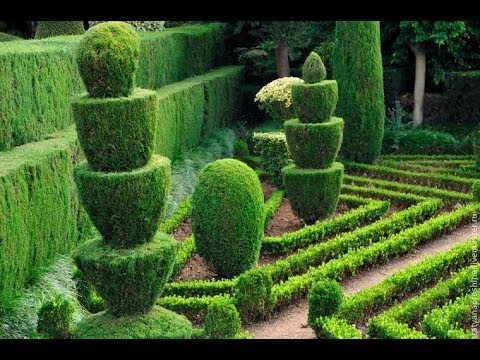

Watch this video on YouTube

